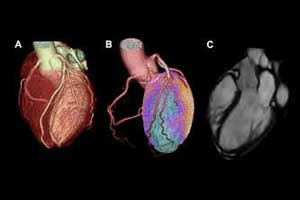- Home
- Editorial
- News
- Practice Guidelines
- Anesthesiology Guidelines
- Cancer Guidelines
- Cardiac Sciences Guidelines
- Critical Care Guidelines
- Dentistry Guidelines
- Dermatology Guidelines
- Diabetes and Endo Guidelines
- Diagnostics Guidelines
- ENT Guidelines
- Featured Practice Guidelines
- Gastroenterology Guidelines
- Geriatrics Guidelines
- Medicine Guidelines
- Nephrology Guidelines
- Neurosciences Guidelines
- Obs and Gynae Guidelines
- Ophthalmology Guidelines
- Orthopaedics Guidelines
- Paediatrics Guidelines
- Psychiatry Guidelines
- Pulmonology Guidelines
- Radiology Guidelines
- Surgery Guidelines
- Urology Guidelines
Cardiac hybrid imaging an excellent predictor for heart attack

A new study published in the journal Radiology finds that, in patients evaluated for coronary artery disease, cardiac hybrid imaging with CT and nuclear stress testing is an excellent long-term predictor of adverse cardiac events like heart attack.
Philipp A. Kaufmann, professor and chair of nuclear medicine, and director of cardiac imaging at University Hospital Zurich, Switzerland, and colleagues conducted the study to determine the value of cardiac hybrid imaging, performed by combining SPECT (single photon emission tomography) myocardial perfusion imaging (MPI) with coronary CT angiography, as a long-term predictor for major adverse cardiac events (MACEs).
Coronary artery disease is a leading cause of disability and death worldwide. Invasive coronary angiography (ICA) is considered the gold standard for determining the percent of stenosis or narrowing, due to plaque in a coronary artery. However, the degree of stenosis on ICA is not always an accurate predictor of heart attack risk because it gives no information on perfusion or the blood flow into the heart muscle. Inadequate perfusion, also known as ischemia, is a potential danger to the patient.
Read Also: PET Imaging more effective than SPECT Scans in detecting severe CAD
"In lesions with less than 50 percent narrowing, one in five lesions still produce an ischemia," said Dr. Kaufmann.
Cardiac hybrid imaging combines coronary computed tomography angiography (CCTA) and myocardial perfusion imaging with single photon emission tomography (SPECT) to provide information on both stenosis and perfusion. The approach has shown promise in studies focusing on short-term observations, but information is lacking on long-term outcomes.
For the study, the research team looked at 428 patients who underwent hybrid imaging.
Key Findings:
- During a median follow-up of 6.8 years, a total of 160 MACEs, including 45 deaths, were observed in the final study population (mean age, 62 years ± 11 [standard deviation]; 132 women).
- Patients with matched findings--stenosis of 50 percent or more on CCTA with evidence of ischemia on SPECT in the area of the heart to which the blocked vessel was supplying blood--had more than five times the risk of adverse events than those with normal findings.
- Patients with unmatched findings, or evidence of ischemia but not in the area of the heart being fed by the stenotic artery, had three times the risk.
- Major adverse cardiac event rates were 21.8 percent for matched findings and 9.0 percent for unmatched--considerably higher than the 2.4 percent rate for normal findings.
Dr. Kaufmann said that hybrid imaging findings could help guide treatment decisions, such as whether or not a patient should have a revascularization procedure such as bypass or angioplasty.
"In patients with multiple lesions or complex coronary anatomy, it is, in many cases, very difficult to correctly identify the culprit lesion," he said. "In a previous multicenter trial, with hybrid imaging, we were able to see that about one in five patients should be revascularized in another coronary artery than originally planned. The present study now documents the prognostic importance of the comprehensive assessment provided by hybrid imaging."
The study supports CCTA use for an initial, noninvasive evaluation of patients with known or suspected stable coronary artery disease. No additional imaging would be necessary if the results were normal. If a lesion was evident, then clinicians could employ a nuclear scan to assess ischemia and take advantage of both modalities by fusing the results together to make a hybrid image.
"In patients evaluated for coronary artery disease, cardiac hybrid imaging is an excellent long-term predictor of adverse cardiac events. A matched hybrid finding is associated with a high annual cardiac event rate. To our knowledge, our study is the first to expand the proven predictive short-term value of cardiac hybrid imaging in a long-term period," concluded the authors.
For further information follow the link: https://doi.org/10.1148/radiol.2018171303

Disclaimer: This site is primarily intended for healthcare professionals. Any content/information on this website does not replace the advice of medical and/or health professionals and should not be construed as medical/diagnostic advice/endorsement or prescription. Use of this site is subject to our terms of use, privacy policy, advertisement policy. © 2020 Minerva Medical Treatment Pvt Ltd